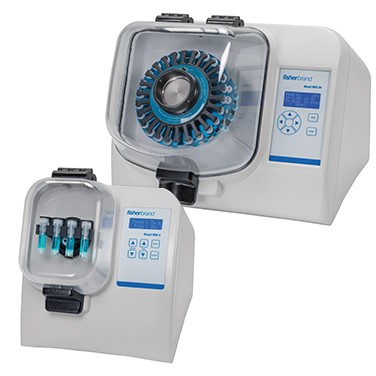Bead Mill Basics
In the science community, time is of the essence and results are critical. Efficiency is crucial when lab personnel need to extract different analytes from a variety of samples.
Sample preparation is especially important with problematic materials or specimens and may create a bottleneck in the overall extraction process. Traditionally, samples were individually and manually processed, sometimes ground using a mortar and pestle or subjected to long enzymatic digestions. Bead mill homogenizers help speed this process up and keep your work on schedule.
How Do Bead Mills Work?
Bead mills are one of the most effective methods for processing samples into smaller particle sizes and can be used to process multiple samples simultaneously.
Bead mills are used for dispersion processing — they reduce the size of solid particles and disperse them into the sample. The beads are placed inside a tube with the sample and agitated vigorously. Homogenization occurs with impact or collisions between the sample and the beads (macro-scale), between the beads and the tube (micro-scale), and shear forces created by rapid bead movement (macro-scale).
Choosing the Right Beads
The type and size of the beads are important factors when processing samples. Larger beads can break down large or dense structures while small beads are more effective with cellular components.
Bead shape and density matter as well. Denser beads will be more effective on tougher or harder materials. Irregularly shaped beads create greater mechanical shear forces and work well with tough or fibrous materials.
The variation in beads makes bead mills suitable for multiple applications. Bead mills can be used to dissociate tissue and recover live cells or extract small molecules like nucleic acids and proteins. Bead mill tubes do not require additional liquid, so they can be used for milling or dry grinding solid samples.
Advantages of Bead Mill Sample Prep
Bead mill homogenizer tubes are disposable — single use reduces the risk of cross-contamination. And because homogenization occurs inside a closed tube, there is less chance of creating aerosols or other user exposure. This is especially important if samples contain toxic, infectious, or otherwise hazardous substances.
Use Fisherbrand Bead Mill Homogenizers for grinding, lysing, or homogenizing biological samples for molecular extractions. A unique tube carriage motion provides efficient bead movement, producing impact forces that match or exceed other bead mills in the market. And increased power reduces processing times to maximize your sample prep efficiency.
- Simultaneously homogenize up to 24 samples
- Front-loading tube holder for convenience, ease of use, and optimal bead/sample interactions
- Non-stop processing — no need to cool down between runs
- Rapid processing means less sample degradation
- Timer range: 1 to 99 seconds
- Performance range: 0.8 m/s to 6 m/s in increments of 1.5 m/s
- Cycles: 1 to 9
- Small footprint
Fisherbrand Bead Mill Homogenizers, coupled with sample-specific bead beating materials, can help you produce thorough homogenates regardless of the sample. Compared to conventional methods, bead mill homogenization increases the yields of nucleic acids, proteins, and other small molecules to improve the results of your downstream assays.

Content provided by:



